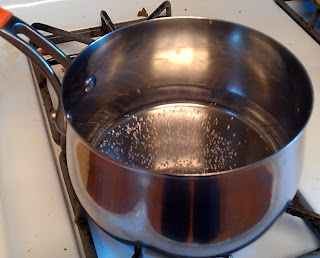To download a copy of the recipe for Strawberry Lovers’
Strawberry Chiffon Pie with Graham Cracker Crust and Shaved White Chocolate,
click HERE.
With the warm weather now upon us, a cool and refreshing
dessert seemed like a good idea. That’s where Strawberry Lovers’ Strawberry
Chiffon Pie with Graham Cracker Crust and Shaved White Chocolate comes in.
Rather than being made with boxed flavored gelatin, or even unflavored gelatin
mixed with fruit juice, this chiffon gets its deeper flavor by using fresh-made
strawberry puree.
Another plus: reducing the fat by making the chiffon with
non-fat powdered milk instead of the usual packaged whipped topping, and using
low-fat graham crackers to form the crust.
Some Cook’s Notes before we begin:
- When forming the pie shell, be sure to press the graham cracker mixture down tight enough to prevent it from falling apart when sliced.
- Much credit to the American Heart Association for publishing recipes that show how easy it is to use non-fat powdered milk to create a fluffy, guilt-free chiffon.
This recipe makes one very delicious 9” pie.
Here’s
what you’ll need.
For the graham cracker crust: 1 cup low-fat graham cracker crumbs (about 12 crackers); 3 Tbsp sugar; 3 Tbsp plus 2 tsp butter substitute, melted and warm; pinch ground cinnamon; and a pinch ground nutmeg.
For the strawberry topping: ½ cup sugar; juice of ½ lemon; ½ lb. hulled fresh strawberries; pinch dry rosemary; salt; and ½ Tbsp firm-textured butter substitute.
For the strawberry chiffon: 1 envelope unflavored gelatin (1/4 ounce); 2 pounds fresh strawberries, hulled and rough-chopped; ½ cup sugar, divided; ½ cup non-fat dry milk; and the juice of one lemon.
For the garnish: shaved white chocolate.
To
prepare the crust:
Place the graham crackers in a food storage bag, squeeze out as much air as possible and, using a rolling pin, crush to a sand-like consistency.
Bake until light brown and firm, about 12 minutes. Set aside to cool.
While
the pie shell is baking, prepare the strawberry topping as follows:
Crush ½ pound of hulled strawberries by hand into the saucepan. (Crushing by hand will give the finished topping a lightly chunky texture.) Add a pinch of rosemary, salt, and ½ Tbsp of butter substitute. Cook to a thick but spreadable texture. (You can check the thickness of the cooled liquid by placing a few drops of the hot liquid onto the plate you put in the freezer and letting it cool.) When the topping has the desired texture, set aside to cool until needed.
To
make the chiffon filling:
Using a blender or food processor, puree the chopped strawberries completely. (This should make about 3 cups of puree.)
In a small saucepan, bring 2 cups of puree to a boil.
Place the non-fat dry milk and ice-cold puree in a mixing bowl.
Beat on high speed 3-4 minutes, or until soft peaks form.
To
complete and serve the pie:
(If there’s leftover chiffon mixture after filling the pie shell, pour it into cups and chill along with the pie until firm. It makes a great dessert treat!)
To download a copy of the recipe for Strawberry Lovers’ Strawberry Chiffon Pie with Graham Cracker Crust and Shaved White Chocolate, click HERE.
Wishing you all a great, refreshing start to the summer season!
Please visit again next week for another delightful treat for your cooking and eating pleasure! Till then, stay well, keep it about the food, and always remember to kiss the cook. ;-)














































